Aqua LinQ Network Interface – Part 4 – Squeezelite

Review sample supplied by Aqua
Retail prices in the NL, including 21% VAT:
LinQ 1 (with one Renderer module, UPnP, HQP, or Squeeze): 6.350 euro
LinQ 2 (with two Renderer modules): 7.590 euro
LinQ Core (with HQP Core + NAA Renderer module): 7.750 euro
Other combinations available
Squeezelite, UPnP, or HQP module: 1.350 euro
In addition to the existing UPnP, HQ Player, and HQ Player Core + NAA modules, Aqua has introduced a Squeezelite renderer module for the LinQ Network Interface, adding ongoing significance to this streamer’s future-proof nature.
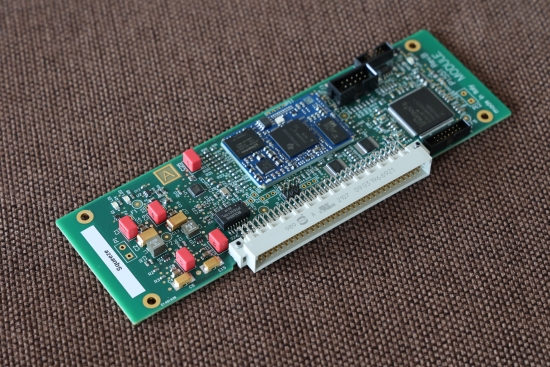
Usually, I make a single review per component, but due to the Aqua LinQ Network Interface’s Modular Nature, this review already marks the fourth installment! If there’s anything this series illustrates just perfectly, it is the benefit of the Aqua components’ modular structure in general and the versatility of the LinQ in particular.
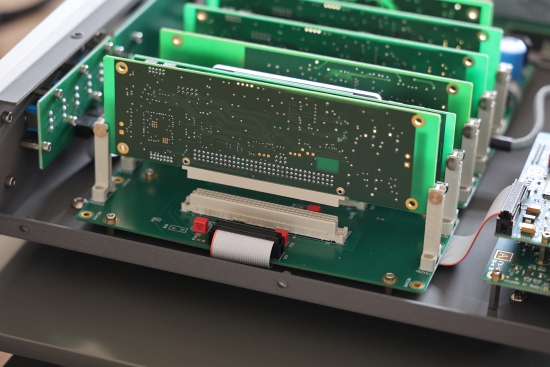
Introduced in June 2020, the LinQ’s functionality has continued growing thanks to new user-installable modules. At present, the LinQ can be ordered in any combination of four available modules the user wants, meaning one need not pay for options they do not need. And thanks to its modular nature, the modules can always be swapped or added later just by inserting them into one of the four internal slots.
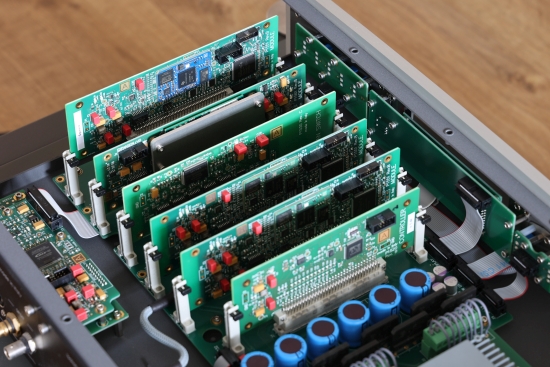
If you’re new to the LinQ, I recommend reading my original LinQ review to learn all the ins and outs. But in short, the LinQ is an RJ45-connected network player, in other words, a streaming endpoint compatible with a wide range of streaming protocols. Aqua made a conscious decision not to use USB for the LinQ in their quest to achieve the best sound. Instead, the unit offers a wide array of connections, such as AQlink, the aqua I2S proprietary connection, as well as S/PDIF on BNC and RCA, AES/EBU, and dual-AES outputs, all derived from a custom FGPA.
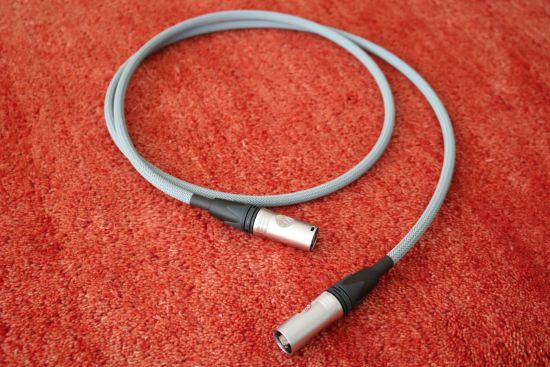
AQlink G2 I2S cable
All outputs, AQlink included, can be used simultaneously. Depending on the selected output, the maximum resolution is PCM 32-bit 384kHz / DSD128.

Squeezelite
Like UPnP, Squeeze is a well-established and long-standing streaming protocol supported by many compatible devices. The most well-known are probably the various incarnations of Logitech Squeezebox. The thing is, although the LMS (Logitech Media Server) software is easy to use, highly stable, and can run on any Windows, MacOS, or Linux computer, the Squeezebox hardware devices are far from the first choice to get the best sound quality. I learned this when Squeezebox was introduced to me in 2009 by my friend Jeroen, who had faith in the future of streaming audio when I was still playing CDs exclusively. To this day, I’m grateful that he introduced me to the streaming world at that time, as it formed the basis of what would become my long quest for attaining the best in streaming audio.
But in 2009, despite trying several high-end DACs of the time, such as Mark Levinson, Wadia, Audiomeca, and others, I could not get the system to sound anywhere as good as the Wadia 861 or Levinson 390S playing a CD. As I later learned, the limitation was not in LMS itself but in the Squeezebox network player hardware.
Although Logitech has long stopped producing Squeeze hardware, the server software and protocol still have a large user base. Further, the SlimProto renderer functionality, which used to be available only in the form of the Squeezebox units, has been converted to an open-source software variant called Squeezelite that can be implemented into other products.
And this is where it gets exciting!
As mentioned, Squeeze’s limitation was not the server software or the protocol but the hardware implementation and processing of the streaming endpoints. A tip of this veil had already been lifted for me when I heard the EC Designs BBB (BeagleBoneBlack) streaming interface in 2015 as part of a review of the company’s Mosaic DAC. The BBB ran an implementation of Squeezelite and provided a digital output via USB. It wasn’t as good as the best servers I had at the time, but it was significantly better than the original Squeezebox player.
Now, imagine my anticipation when Aqua confirmed to be working on a Squeezelite Renderer module for the LinQ!
The module has been a reality since late 2023, and I’ve just received a review sample. I added it in the last slot (M4) of my LinQ, next to the UPnP and HQ Player Core + NAA modules, and used it for almost a week before making serious assessments.
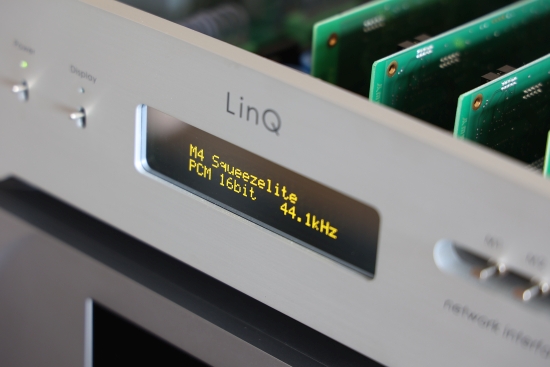
LMS/Squeeze Operation
Like Roon, LMS/Squeeze is a three-tier ecosystem consisting of a Server, Player, and Controller.
The server part is Logitech Media Server (LMS), freeware software that runs on Windows, MacOS, or Linux computers. Installation is easy and requires no special knowledge.
The player part originally came in the shape of the original Squeezebox hardware, but more recently as Squeezelite. This software implementation can run on custom devices like the Aqua Squeezelite renderer module. Although the software is user-installable, the complication is to make it sound really good. Receiving a stream is one thing; converting it into pristine sound and relaying this via a transparent digital audio interface is quite another. This is where Aqua’s expertise comes in.
There are multiple ways of controlling Squeeze. Logitech has always had a native LMS interface. For the longest time, the interface looked dated, and until not that long ago, I much preferred the third-party iPeng app. However, with the introduction of the Material Skin for the LMS interface, this has been completely turned around. Material Skin has a beautifully clean and easy-to-use layout.
Compatibility
The LMS control interface works on any device with a web browser and any operating system. This includes desktops, phones, and tablets running Windows, Linux, MacOS, iOS, iPadOS, and Android. The LinQ with Squeezelite renderer module is automatically seen as a native zone in the LMS.
Squeeze also works well with the Innuos Sense Interface in combination with an Innuos server.
Lastly, and quite importantly, the Roon ecosystem natively supports Squeezelite. After enabling support for Squeeze in Roon settings, you can add the LinQ as an endpoint in Roon and stream to it directly. Like LMS, Roon runs on most devices and operating systems, including MacOS, iOS, Windows, and Android.
Next: Configuration
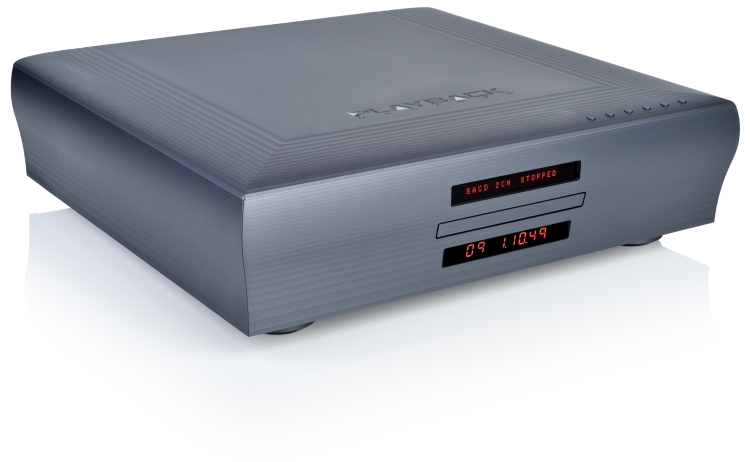






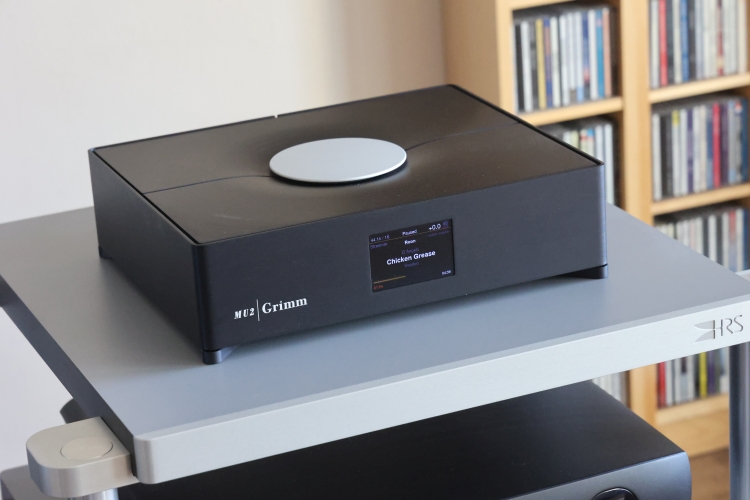
Hello Christiaan.,
Just read your new review regarding Aqua LinQ Network Interface -Squeezelite. And, you mentioned about Innuos Sense interface. If I’ll go for the LinQ as an endpoint renderer and have an Innuos Zen mk3, which I intend to use as a server, how could I connect both ? Innuos has only an USB connection for DAC and a RJ45 for connecting a streamer.
Could I use the RJ45 Aqua I2S connection ? this is the only way I guess
Hi Calin, The LinQ is a streaming endpoint, meaning that its input will always be a network connection. The protocol that can be used depends on the chosen module for the LinQ. The Innuos can function as a server, connected to a network switch. The LinQ also connects to a network switch on the same network, preferably the same switch. AQlink is no a network connection, it is Aqua’s implementation of teh I2S protocol. I2S was originally an IC to IC comms protocol. It carries separate data and clock signals, contrary to AES/EBU and S/PDIF. The downside of I2S is that it is not designed for long distances. This is what Aqua have addressed with their AQlink implementation.
And on more question please: if I don’t intend to enable and use Roon, could I go for the HQ player only ? with using same cofiguration described above ? Which module do I need inside LinQ ?
If your server supports HQP (either standalone or as part of another music software application), then you can use the LinQ with the HQP module. There are two options for that: basic and Core + NAA. There’s more information in my earlier installments of the LinQ review.
Alternatively, easier solutions are to use Squeeze server (LMS) with the Squeeze module, or MinimServer (UPnP) with the UPnP module.
Hi Christiaan
Are the cables used in this test still belden 19364 2.1mm and Oyadie c004 and Bals Schuko? I recently bought a belden 19364 cable, and the sound is very neutral and I am very satisfied. May I ask if you have connected the shield wire and ground wire in the cable to the ground terminal of the tail Oyadie C004? In addition, the European standard plug model of Bals Schuko is 7370, right? Thank you
Hi Nicholas, actually, I started using different cables and only still use the Belden for the A1.5 power amp. If you follow the “Main System” link in the review, you will see a Setup Snapshot page detailing all components and cables used at the time of that review.
Brand-name cables used:
– GigaWatt LC-2 EVO (with CH C1.2 DAC)
– GigaWatt PowerSync ULTRA (with CH L1 preamp)
– Belden 19364 with Bals schuko and Oyaide C004 IEC connectors (with A1.5 power amp)
The other components use one of the two following home-made cables:
– Block CUL 500 Enamelled solid core copper in PTFE tubing w. OEM Rhodium schuko and Oyaide 004
– OEM tinned litze in PTFE dielectric with OEM Rhodium-plated schuko and Oyaide 004
The Bals schukos I used were always Type 73 but these have been discontinued a few years back. They are superseded by the 7370. The older 73s sound a little leaner and faster, the newer ones have a little more voluminous tone.
I always attach the shield drain wire only to the wall/power-distributor side’s earth connector, not on the component side. I like the OEM Rhodium schukos a little more, they are more like the old Bals schukos and just a tad brighter, but given that they are sourced from Aliexpress and are not branded, there’s no telling what make they are.
Hello, great reviews. I really enjoy your content. I’m looking at the Antepodes k22 and the Aqua LinQ as my next transport and wondering if you would be able to compare and contrast their sound characteristics and performance? I’m upgrading DACs and looking at the MSB Discrete to pair with either transport.
Hi Javier, please see the Antipodes reviews for all comparisons I did.
Hello Cristiaan,
If using JPlay only, no Roon, which module ultimately gives the best sound, HQP Core + NAA or UPnP DLNA module?
Between HQP+NAA via Roon and UPnP native, I prefer the latter for its purer sound. However, I have only listened to the former using Roon, which also affects performance.